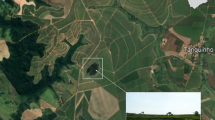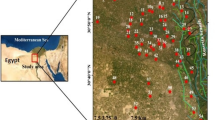Abstract
Vairavanpatti is a rural area in the district of Sivagangai, Tamil Nadu, India, prone to water deficiency. Azimuthal square array for vertical electrical sounding (VES) techniques were used to delineate the geoelectrical layers at five different locations. Groundwater samples were collected in 15 locations and analyzed for pH, EC, TDS, TH, T-Alk, Ca, Cl, SO4, Fe, and SiO2 levels. The minimum and maximum apparent resistivity values recorded in location 5 with 37.6 Ωm and location 4 with 1150.7 Ωm. Most of the quality parameters exceeds the WHO (2008) and BIS (2012) guideline values except pH and SO4. Iso-resistivity maps for apparent resistivity values suggest at 10-m intervals a total depth of 80 m. The iso-resistivity maps and spatial distribution maps were reclassified with respect to their desired values based on WHO (2008) and BIS (2012) guidelines for drinking water. Analytical hierarchy processes (AHPs) were used to assign the weights for each reclassified layers. The relative importance of layers for potable groundwater and potential zone were identified, in which the consistency ratio is kept as below 0.1. The result shows that the 23% groundwater of northern part is not suitable for drinking purposes. In the overall study area, 51.33% of the southwest, southeast, and central parts possess potable groundwater with moderate potential. In northern part, 22.42% have non-potable and moderate potential while 13.38% of the northeastern part contains good potential of potable groundwater. All other categories are 12.21% of potable and poor potential, 0.5% of non-potable with good potential, and 0.16% of non-potable with poor potential of groundwater in the study area. Rainwater harvesting and artificial recharge must be implemented in these areas to improve the potential and quality of groundwater. It is understood that AHP-enabled GIS can be used effectively in the identification of potable and potential groundwater zone in any complex regions.











Similar content being viewed by others
References
Ajin RS, Jacob MK, Vinod PG (2014) Tsunami vulnerability mapping using remote sensing and GIS techniques: a case study of Kollam District, Kerala, India. Iranian J Earth Sci 6(1):43–50 http://www.researchgate.net/publication/269169047
APHA (1995) Standard methods for the examination of water and waste-water, 19th edn. American Public Health Association, New York
Appelo T, Postma D (2005) Geochemistry, Groundwater and Pollution. A.A. 1996
BIS (2012) Specification for drinking water IS: 10500:1991. Bureau of Indian Standards, New Delhi
Cabrera JS, Lee HS (2019) Flood-prone area assessment using GIS-based multi-criteria analysis: a case study in Davao Oriental, Philippines. Water 11(11):2203. https://doi.org/10.3390/w11112203
Central Groundwater Board (CGWB) (2008) District groundwater brochure of Sivagangai, Tamil Nadu
Chandra S, Auken E, Maurya PK, Ahmed S, Verma SK (2019) Large scale mapping of fractures and groundwater pathways in crystalline hardrock by AEM. Sci Rep 9(1):1–11. https://doi.org/10.1038/s41598-018-36153-1
Chandrasekar N, Selvakumar S, Srinivas Y, John Wilson JS, Simon Peter T, Magesh NS (2013) Hydrogeochemical assessment of groundwater quality along the coastal aquifers of southern Tamil Nadu, India. Environ Earth Sci 71(11):4739–4750. https://doi.org/10.1007/s12665-013-2864-3
Chidambaram S, Bala Krishna Prasad M, Manivannan R, Karmegam U, Singaraja C, Anandhan P, Prasanna MV, Manikandan S (2012) Environmental hydrogeochemistry and genesis of fluoride in groundwaters of Dindigul district, Tamilnadu (India). Environ Earth Sci 68:333–342. https://doi.org/10.1007/s12665-012-1741-9
Chidambaram S, Anandhan P, Prasanna MV, Srinivasamoorthy K, Vasanthavigar M (2013) Major ion chemistry and identification of hydrogeochemical processes controlling groundwater in and around Neyveli Lignite Mines, Tamil Nadu, South India. Arab J Geosci 6(9):3451–3467. https://doi.org/10.1007/s12517-012-0589-3
Chung SY, Rajendran R, Venkatramana S, Sekar S, Ranganathan PC, Oh YY, Elzain HE (2020) Processes and characteristics of hydrogeochemical variations between unconfined and confined aquifer systems: a case study of the Nakdong River Basin in Busan City, Korea. Environ Sci Pollut Res 27:10087–10102. https://doi.org/10.1007/s11356-019-07451-6
Coker JO, Makinde V, Olowofela JA (2009) Geophysical investigation of groundwater potentials of Oke-Badan estate, Ibadan, southwestern, Nigeria. Proceedings of 3rd International Conference on Science and National Development University of Agric. Abeokuta, p 119
Conrad O, Bechtel B, Bock M, Dietrich H, Fischer E, Gerlitz L, Wehberg J, Wichmann V, Böhner J (2015) System for Automated Geoscientific Analyses (SAGA) v. 2.1.4. Geosci Model Dev 8(7):1991–2007. https://doi.org/10.5194/gmd-8-1991-2015
Dasgupta AM, Purohit KM (2001) Status of surface and groundwater quality of Mandiakadar-part II: agricultural utilities. Pollut Res 20(2):219–225
Fenta AA, Kifle A, Gebreyohannes T, Hailu G (2014) Spatial analysis of groundwater potential using remote sensing and GIS-based multi-criteria evaluation in Raya Valley, northern Ethiopia. Hydrogeol J 23(1):195–206. https://doi.org/10.1007/s10040-014-1198-x
Gangadharan R, Nila RP, Vinoth S (2016) Assessment of groundwater vulnerability mapping using AHP method in coastal watershed of shrimp farming area. Arab J Geosci 9(2):1–14. https://doi.org/10.1007/s12517-015-2230-8
Gnanachandrasamy G, Ramkumar T, Venkatramanan S, Vasudevan S, Chung SY, Bagyaraj M (2015) Accessing groundwater quality in lower part of Nagapattinam district, Southern India: using hydrogeochemistry and GIS interpolation techniques. Appl Water Sci 5(1):39–55. https://doi.org/10.1007/s13201-014-0172-z
Gnanachandrasamy G, Zhou Y, Bagyaraj M, Venkatramanan S, Ramkumar T, Wang S (2018) Remote sensing and GIS based groundwater potential zone mapping in Ariyalur District, Tamil Nadu. J Geol Soc India 92(4):484–490. https://doi.org/10.1007/s12594-018-1046-z
Habberjam GM (1972) The effects of anisotropy on square array resistivity measurements. Geophys Prospect 20:249–266
Habberjam GM (1975) Apparent resistivity, anisotropy and strike measurements. Geophys Prospect 23:211–247
Habberjam GM (1979) Apparent resistivity observations and the use of square array techniques. In: Saxov S and Flathe H (eds) Geoexploration Monographs. series 1, no 9, pp 1–152
Habberjam GM, Watkins GE (1967) The use of a square configuration in resistivity prospecting. Geophys Prospect 15:221–235
Hem JD (1991) Study and interpretation of the chemical characteristics of natural waters. Book 2254, 3rd edn. Scientific Publishers, Jodhpur
Ibrahim I, Asmawi MZ, Jaafar S (2017) Temporal geospatial shorelines changes analysis in Klang coastal area. Adv Sci Lett 23(7):6362–6366. https://doi.org/10.1166/asl.2017.9270
Juahir H, Zain SM, Yusoff MK, Hanidza TIT, Armi ASM, Toriman ME, Mokhtar M (2011) Spatial water quality assessment of Langat River Basin (Malaysia) using environmetric techniques. Environ Monit Assess 173(1–4):625–641. https://doi.org/10.1007/s10661-010-1411-x
Kanagaraj G, Suganthi S, Elango L, Magesh NS (2019) Assessment of groundwater potential zones in Vellore district, Tamil Nadu, India using geospatial techniques. Earth Sci Inf 12(2):211–223. https://doi.org/10.1007/s12145-018-0363-5
Karanth KR (1997) Groundwater assessment, development and management. Tata McGraw-Hill, New Delhi
Khurshid SH, Hasan N, Zaheeruddin (2002) Water quality status and environmental hazards in parts of Yamuna– Karwan sub-basin of Aligarh–Mathura district, Uttar Pradesh, India. J Appl Hydrol 14(4):30–37
Krishna kumar S, Logeshkumaran A, Magesh NS, Godson PS, Chandrasekar N (2014) Hydro-geochemistry and application of water quality index (WQI) for groundwater quality assessment, Anna Nagar, part of Chennai City, Tamil Nadu, India. Appl Water Sci 5(4):335–343. https://doi.org/10.1007/s13201-014-0196-4
Machiwal D, Jha MK, Mal BC (2011) Assessment of groundwater potential in a semi-arid region of India using remote sensing, GIS and MCDM techniques. Water Resour Manag 25(5):1359–1386. https://doi.org/10.1007/s11269-010-9749-y
Majumdar D, Gupta N (2000) Nitrate pollution of groundwater and associated human health disorders, India. J Environ Health 42(1):28–39
Mohamed AS, Thirumaran G, Arumugam R, Ragupathi RKR, Anantharaman P (2009) Physico- chemical parameters of holy places Agnitheertham and Kothandaramar Temple; southeast coast of India. Am Eurasian J Sci Res 4(2):108–116
Mondal S (2012) Remote sensing and GIS based ground water potential mapping of Kangshabati irrigation command area, West Bengal. J Geogr Nat Disasters 01(01):1–8. https://doi.org/10.4172/2167-0587.1000104
Pinto D, Shrestha S, Babel MS, Ninsawat S (2017) Delineation of groundwater potential zones in the Comoro watershed, Timor Leste using GIS, remote sensing and analytic hierarchy process (AHP) technique. Appl Water Sci 7(1):503–519. https://doi.org/10.1007/s13201-015-0270-6
Pulle JS, Khan AM, Ambore NE, Kadam DD, Pawar SK (2005) Assessment of groundwater quality of Nanded City. Pollut Res 24(3):657–660
Rahimi D, Mokarram M (2012) Assessing the groundwater quality by applying fuzzy logic in GIS environment-a case study in Southwest Iran. Agris On-Line Pap Econ Inform 2(3):1798–1806. https://doi.org/10.6088/ijes.002020300063
Ramachandran A, Sivakumar K, Shanmugasundharam A, Sangunathan U, Krishnamurthy RR (2020) Evaluation of potable groundwater zones identification based on WQI and GIS techniques in Adyar River basin, Chennai, Tamilnadu, India. Acta Ecol Sin. https://doi.org/10.1016/j.chnaes.2020.02.006
Ravindran A, A (2012) Azimuthal square array configuration and groundwater prospecting in quartzite Terrian at Edaikkal, Ambasamudram, Tirunelveli. Res J Earth Sci 4(2):49–55
Ravindran A, A, Muthusamy S, Moorthy G, Vinothkingston J, Mohana P (2018) Groundwater – quartzite area study using square array method in Puthukottai, Tuticorin District, Tamilnadu, India. Int J Adv Multidiscip Sci Res 1(10):43–54. https://doi.org/10.31426/ijamsr.2018.1.10.1016
Saaty TL (1980) The analytic hierarchy process. McGraw-Hill, New York, p 278
Sawyer CN, McCarty PL (1978) Chemistry for Environmental Engineering, 3rd edn. McGraw-Hill Book Co., New York
Selvam S, Venkatramanan S, Singaraja C (2015) A GIS-based assessment of water quality pollution indices for heavy metal contamination in Tuticorin corporation, Tamilnadu, India. Arab J Geosci 8(12):10611–10623. https://doi.org/10.1007/s12517-015-1968-3
Selvam S, Venkatramanan S, Chung SY, Singaraja C (2016) Identification of groundwater contamination sources in Dindugal district of Tamil Nadu, India using GIS and multivariate statistical analyses. Arab J Geosci 9(5). https://doi.org/10.1007/s12517-016-2417-7
Sivakumar K, Priya J, Muthusamy S, Saravanan P, Jayaprakash M (2016) Spatial diversity of major ionic absorptions in groundwater : recent study from the industrial region of Tuticorin, Tamil, Nadu, India. EnviroGeoChemica Acta 3(1):138–147
Sivakumar K, Muthusamy S, Jayaprakash M, Mohana P, Sudharson ER (2017) Application of post classification in landuse & landcover strategies at north Chennai industrial area. J Adv Res Geo Sci Remote Sens 4(3&4):1–13
Subba Rao N (2006) Seasonal variation of groundwater quality in a part of Guntur district, Andhra Pradesh, India. Environ Geol 49:413–429
Sujatha D, Redd RB (2003) Quality characterization of groundwater in the south-eastern part of the Ranja Reddy district, Andhra Pradesh, India. Environ Geol 44(5):579–586
Venkatramanan S, Chung SY, Kim TH, Prasanna MV, Hamm SY (2015) Assessment and distribution of metals contamination in groundwater: a case study of Busan City, Korea. Water Qual Expo Health 7(2):219–225. https://doi.org/10.1007/s12403-014-0142-6
Venkatramanan S, Chung SY, Selvam S, Lee SY, Elzain HE (2017) Factors controlling groundwater quality in the Yeonjegu District of Busan City, Korea, using the hydrogeochemical processes and fuzzy GIS. Environ Sci Pollut Res 24(30):23679–23693. https://doi.org/10.1007/s11356-017-9990-5
WHO (1996) Trace elements in human nutrition and health. Geneva, ISBN: 9241545143
WHO (2008) Guidelines for drinking water quality. vol 1. Recommendations, 3rd edn. WHO, Geneva, p 515
Zaporozec A (1972) Graphical interpretation of water quality data. Groundwater 10(2):32–43
Funding
This article has been written with the financial support of RUSA – Phase 2.0 grant sanctioned vide letter no. 24-51/2014-U, Policy (TNMulti-Gen), Department of Education, Government of India, dated 09.10.2018.
Author information
Authors and Affiliations
Corresponding author
Ethics declarations
Conflict of interest
The authors declare that they have no conflict of interest.
Additional information
This article is part of the Topical Collection on Recent advanced techniques in water resources management
Rights and permissions
About this article
Cite this article
Kulandaisamy, P., Karthikeyan, S. & Chockalingam, A. Use of GIS-AHP tools for potable groundwater potential zone investigations—a case study in Vairavanpatti rural area, Tamil Nadu, India. Arab J Geosci 13, 866 (2020). https://doi.org/10.1007/s12517-020-05794-w
Received:
Accepted:
Published:
DOI: https://doi.org/10.1007/s12517-020-05794-w




